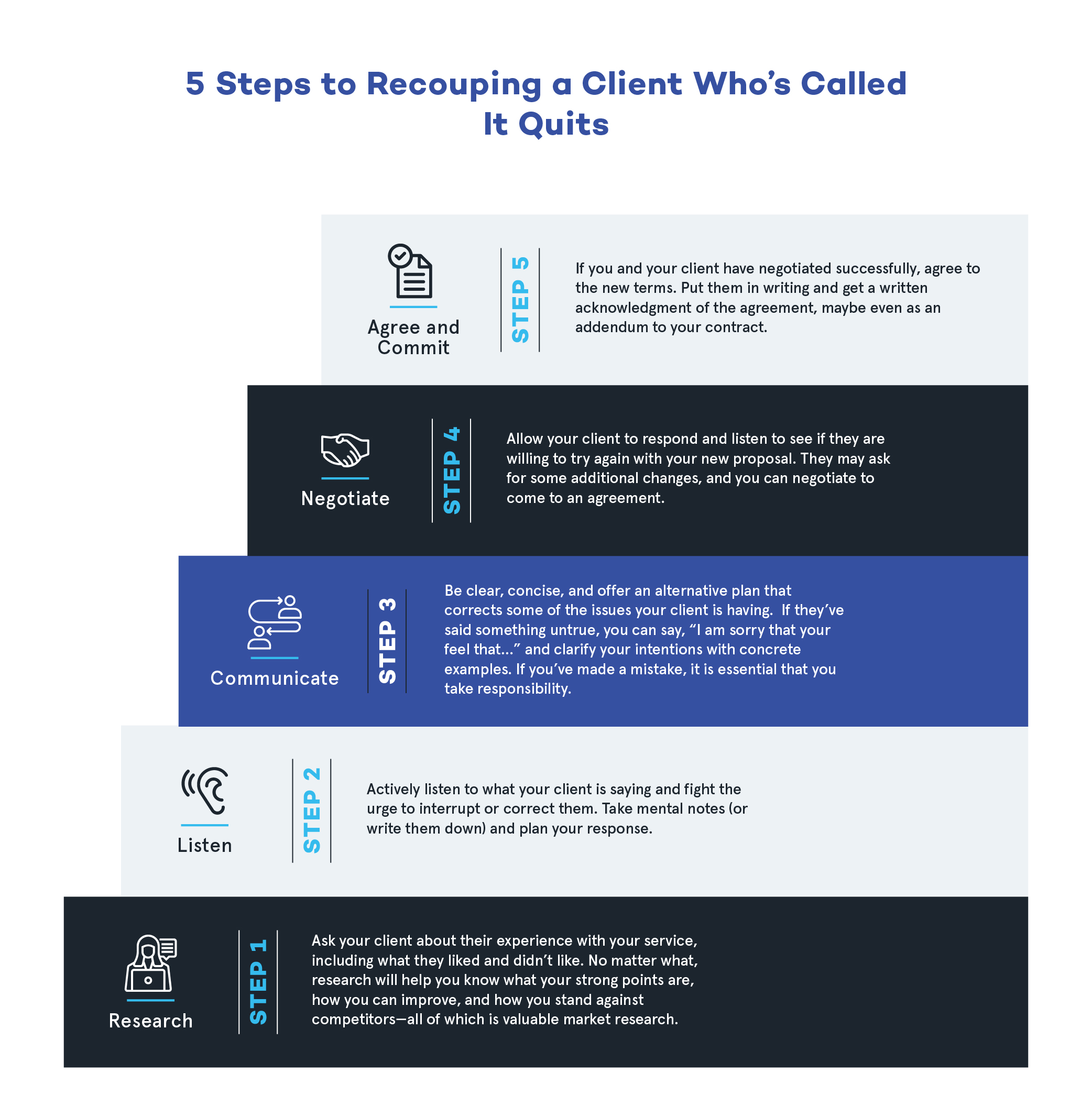Losing a client: It is a source of anxiety for many health and wellness coaches.
When you feel like you are losing a client, what is the appropriate way to react? When a coach-coachee relationship is at risk, is there a way to save it?
Unfortunately, there is no easy answer to these questions. Most coaches will tell you it is difficult to navigate the situation sensitively, show you genuinely care about your client, and simultaneously try to save the client-coach relationship.
So, how do you communicate with clients who are deciding to “break up with you”?
In this article, we provide you with an easy-to-understand guide about how to communicate with clients who have decided to end their relationship with you.
We will walk you through the different motivations behind clients’ decisions and how to react when faced with each of them. We will also ask you important questions about whether or not you think the client is worth saving. Finally, we will provide you with a step-by-step guide to trying to recoup the client relationship.
A Note about Contracts
When your business starts small, potentially with people you already knew before launching your business, it can be easy to overlook the importance of creating contracts. They may seem overly-formal or off-putting, so you may leave them out altogether.
However, when you run into difficulties with your clients, the importance of a contract becomes clear. Ultimately, it is a document that spells out the responsibilities and commitments of each party (you and your client), and it also makes clear what should happen if either you or your client can no longer meet those responsibilities or commitments or if either party simply wants to end the contract.
You should write your contract template in a way that is fair to both you and your client. Your client shouldn’t feel like they are being “roped into” anything they aren’t in agreement with, and it should also protect you from non-complying clients.
4 Main Reasons Clients Leave Their Coaches and How to Troubleshoot
Clients can choose to end the relationship they have with you for a variety of reasons. Since, as a coach, you build a personal relationship with your clients, sometimes the decision can feel like a breakup. Depending on the type of environment you’ve built in your business, emotions may run high, and you or your client may express feelings of betrayal, disappointment, discomfort, and more.
However, no matter how well you get along with your clients, keep in mind that it is a contractual relationship—you are providing a service your client finds valuable in exchange for money.
Ultimately, when a client has chosen to end the contract, it might be because of unhappiness with contract terms or a feeling that contract terms aren’t being met.
Below, we go into detail about the four main reasons a client may choose to leave you and how to troubleshoot each of them to see if the contract (and thus the client) can be saved.

Get Your Free Guide
Learn How to Start a Fulfilling, Impactful Career as a Holistic Health Coach
You’ll learn:
- Why holistic health matters
- If holistic health coaching is right for you
- What career opportunities exist for health coaches
- And more!
They Don’t Feel Like They Can Keep Up (They’re Quitting)
When most clients successfully complete a week of coaching sessions, they usually feel re-energized, healthier, empowered, and stronger. However, if they consistently feel like they aren’t able to meet the goals set out in their meal or fitness plan, each day that goes by can feel like a big weight on their shoulders. Rather than helping them manage their stress, their health and wellness or fitness plan just adds to the stress.
Finally, after over a month of feeling like they can’t keep up, they come to the realization that they need to be honest with themselves. They are no longer able to manage the stress failing to stick to the commitments they’ve made to you, and they need to quit.
In most quitting cases, clients are happy with what coaches have to offer, but it’s just not a good time for them to fully commit.
Important note: Remember that, as health practitioners, the work you do is often very, very personal. It is important to always create a safe space for your clients to express themselves openly. The human relationship with our health and our body image can be a source of difficult emotions and even trauma. As such, it is completely normal for your client to have an emotional reaction, and, when possible, it’s important to try and get to the root cause of the emotion.
How to Support Quitting Clients
Whatever you do, don’t call your client a quitter or get mad at them for not finishing your program. It is normal to feel frustrated, especially if you feel your client is just being lazy or making up excuses. However, escalating the situation will only make things worse.
Let them know that you commend them for being in tune with their physical and mental limitations and taking steps to protect their wellbeing. Ask them what parts of the program were most difficult for them to follow or caused the most stress. If it fits within your vision and business model, you can offer to modify the program so it makes more sense for their lifestyle.
Sometimes, clients will accept the new program, but sometimes they won’t. If they have stuck to their decision to quit, respect their choice, and let them know you will be happy to take them back in the near future if they choose to.
They Are Unhappy with the Experience (They’re Firing You)
This can be one of the most uncomfortable ways to lose a client. It can be hard to navigate without escalating the situation, especially if your client is being confrontational. It can also be hard to learn to admit fault where relevant.
Your client could be unhappy with the services you offer because:
- They expected something you don’t offer.
- They misunderstood your program offerings.
- They realized that your program offerings aren’t working for them.
- They feel that you haven’t followed through with your commitments as a coach.
- They feel that you haven’t been giving them the attention they deserve as your client.
- And many more…
Some clients will communicate that they have fired you directly, either in-person or by phone, and they can take on an angry or bothered tone or a more disappointed, concerned, or sad tone. Some clients might just completely disappear on you, no longer responding to your messages or paying for your services.
How to Troubleshoot Situations with Clients Who Want to Fire You
No matter what tone your client takes with you, it is essential to remain calm and professional. Ask them what they feel went wrong. If you are aware that you have made a mistake, it is important to admit fault. Offer them alternatives: Would they be willing to keep the contract active if you offered them a deal on an upgraded package? Do they want more or less regular check-ins with you? Perhaps you can offer a free session of some sort? For some clients, this might be enough to save the contract, but for others, they might be committed to ending the contract.
If this is the case, speak to them respectfully, tell them you understand why they are making their decision, and let them go.
Note that if you have a client that is not responding to your messages at all, it is best to stop messaging them. If they have pending invoices with you, you can keep sending automated invoice reminders. However, if the amount they owe you is, you may want to consider hiring a collections agency.
This is a great example of when it is important to have clear contractual terms. Before things get difficult, lean on the contract you both agreed to, and, if need be, seek legal support to enforce contract terms.
They’ve Found a Service They Perceive as Better for Them (They’re Exchanging You)
Sometimes, your client will find a coach who offers programs they feel are a better fit for their goals or lifestyle. You can deal with this situation in a similar way to how you would react to a client quitting on you. Note that sometimes clients don’t want to tell you that they have gone with someone else and instead will make up a reason related to other limitations they have. As you question them, you can ask whether they have found another coach.
They aren’t telling you that your programs are inadequate but rather that they have found a program that works better for them.
How to Troubleshoot Situations with Clients Who Want to Exchange You
Be as polite as possible, and thank your client for reaching out to you. Ask them to give you a bit more information about why they are quitting. If you suspect they might have gone with another coach but haven’t said anything, you can directly ask them whether they’ve found a program that works better for them. Ask whether there are any program elements that you offer that they don’t like or wish you had.
Again, if you feel like it is possible, you can offer program alternatives that fit their needs, and you might be able to recoup your client.
Financial or Time Limitations
This reason is quite straight-forward. A client may want to close their contract with you because they can no longer afford it or have new or changing commitments that may not give them enough time to dedicate to your coaching program.
How to Troubleshoot Situations with Clients Who Have Financial or Time Limitations
If the client’s limitations are financial, you may want to consider offering a discount to the client in the interest of keeping them or downselling them. Downselling is a marketing technique where you offer a more affordable solution that meets a client’s needs. If downselling is successful, you still have income from the client, even if it is less than before.
If the client’s limitations are time-based, you can consider offering them a less time-consuming program. Perhaps you can offer them fewer one-on-one meetings or shorter exercise routines.
In many cases, clients who have chosen to let you go due to financial or time limitations are not saveable. They’ve already made a difficult decision to cut things out of their budget, so revisiting the possibility may irritate them. If this is the case, politely thank them for trusting you to coach them, and let them know you are happy to take them back if their situation changes.
{{cta(‘ec238631-a07b-4fd1-9cf0-fad43ad170e3’)}}
Ask Yourself: Do You Really Want to Save This Client?
Speaking frankly, some clients are more trouble than they’re worth. Even if you are tight for income, if a client is demanding, difficult, or constantly making up excuses to avoid progress, you might want to think about letting the client go.
Ask yourself if the client is really worth the investment of time, energy, and stress.
Your urge to help as a coach may make the decision to let a client go difficult because you may feel like you are giving up on them. However, if you’ve spent countless hours complaining about this client or if you’ve invested extra time trying to keep them satisfied with little thanks on their part, you might want to consider seeing it as an opportunity in disguise to let them go. Remember, if you get to the point of burning out, not only is it not good for your own health, you won’t be able to give your other clients your all. You can read more about how to avoid burning out here.
Steps to Recouping a Client Who’s on Their Way Out
So, what do you do if you want to try and get a client back on board after they’ve expressed wanting to end the contract? The steps to recouping a client can be summarized as follows:
- Research
- Listen
- Communicate
- Negotiate
- Agree and commit
Throughout these steps, try to keep two soft skills fresh in your mind. First is empathy. Try to put yourself in their shoes and show that you genuinely understand where they are coming from. If you are able to establish this early on, your client will lower their guard, and it will be easier to try and help them see things another way.
Second, do not escalate. No matter how rude or angry your client is, don’t yell back at them. Try to stay calm and patient at all times. Once you lose your temper, there is no turning back.
Here are the five steps to recouping a client explained.

Research
Spend some time asking your client about how they’ve felt being your client and coachee, what they’ve liked about it, how you’ve been able to help them, and what you could do to improve. If your client is switching over to another program, try to get the name of the program or at least information about what makes it a better fit for them. Even if you aren’t able to keep the client on board, at the very least, you will know what your strong points are, how you can improve, and how you stand against competitors—all of which is valuable market research.
Listen
Actively listen to what your client is saying. As they speak and you are anxious about losing the client, you might feel the urge to interrupt or correct them. Let your clients finish what they are saying, and pay attention to their tone and any emotions that are coming through their words. Take mental notes (or write them down), and plan your response.
Communicate
Once your client has finished expressing themselves, respond to them. Be respectful of their opinions, and do not correct them. If they’ve said something untrue, you can say, “I am sorry that your feel that…” and clarify your intentions with concrete examples.
If you’ve made a mistake, it is essential that you take responsibility.
Avoid going on and on with your response, as it might begin to feel like a sales call or it could annoy your client, and it’s hard to go back from there.
Finally, in this step, you want to propose something concrete that responds to the concerns your client has expressed.
Negotiate
Once you have said your part, allow your client to respond and listen to see if they are willing to try again with your new proposal. They may ask for some additional changes, and you can negotiate to come to an agreement.
Agree and Commit
If you and your client have negotiated successfully, agree to the new terms. Put them in writing and get a written acknowledgment of the agreement, maybe even as an addendum to your contract.
Both verbally and in written form, state your commitments and those of your client. Both of you should feel relieved and comfortable at this point. If you aren’t, you might have to revisit the negotiation process.
In some cases, it isn’t possible for you to come to an agreement, or your client is set on letting you go. If that is the case, it is important to know how to make a dignified exit. Thank them for the opportunity to have worked with them to improve their health.
Main Takeaways
For most business owners, losing a client can be stressful. The same is true for fitness and health and wellness coaches who have built personal one-on-one relationships with their clients.
In some cases, it is possible to bring clients back on board, and we’ve provided some simple steps you can follow above to do so.
Keep in mind that sometimes a client is committed to parting ways, and it is equally important for you to take on a professional tone, thank them for trusting you with their health goals, and wish them well.

Get Your Free Guide
Learn How to Start a Fulfilling, Impactful Career as a Holistic Health Coach
You’ll learn:
- Why holistic health matters
- If holistic health coaching is right for you
- What career opportunities exist for health coaches
- And more!



